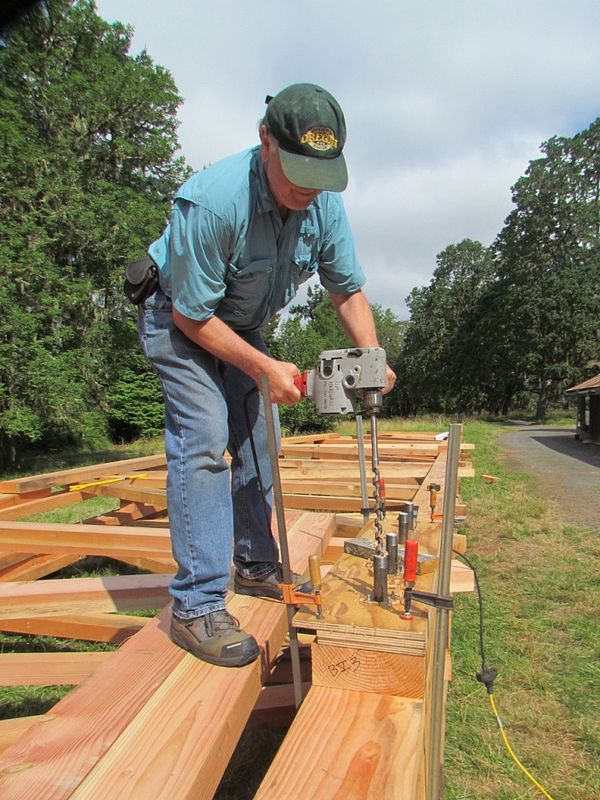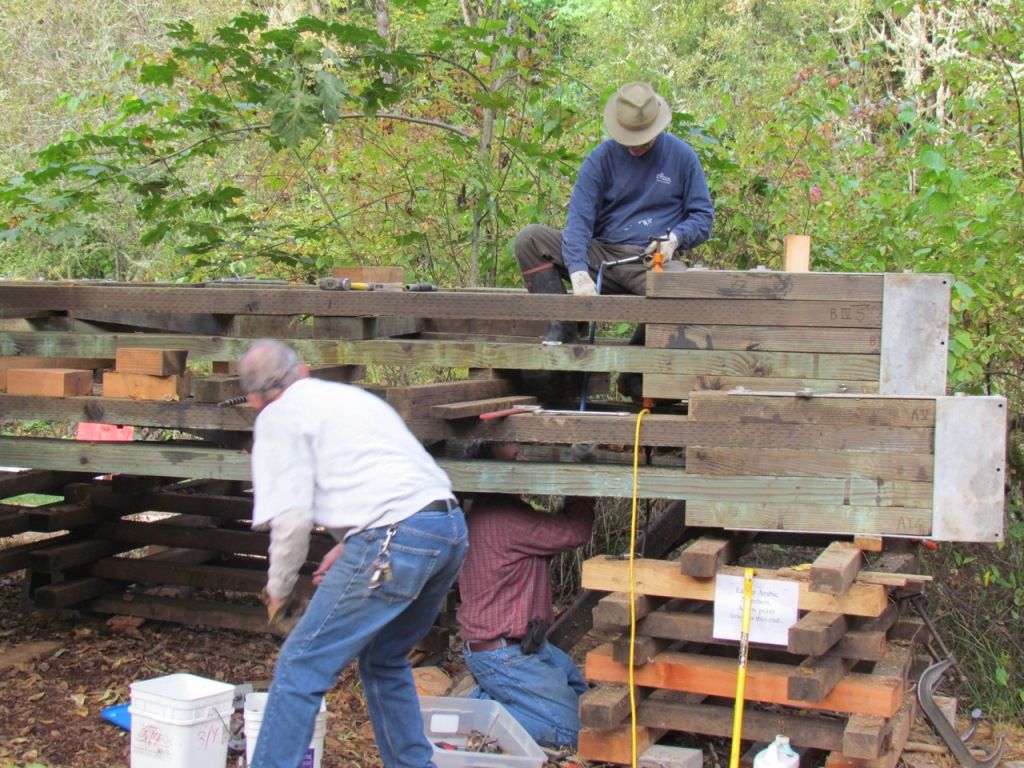Okay, I will take that for a yes that you want to see more of the bridge.
I hike quite a bit on a mountain called Mt. Pisgah. Mt Pisgah is a nonprofit organization that maintains over 275 acres with over 16 miles of trails on a shoestring, donated budget. Pisgah also borders Buford park which brings both to a total of around 3,000 acres.
I feel like I have done well in my life and part of each year I try to get involved volunteering time or money or both to worthwhile causes. At a fund raising event I was talking with the manager and offered to volunteer to help on some limited project. Brad said there was an upcoming bridge project and I anticipated a 20 ft. bridge over one of the small streams. "I think I can do that," I responded.
This was the first large volunteer project I had undertaken. Fortunately, I had the time to spend as needed to pull the project together. In many ways it was a lot like commercial building projects I had undertaken except the personnel fluctuated more. Over time we were able to gauge our volunteers better. In addition, a friend of mine with a construction background returned from summer in Europe.
Well, here is the bridge project, all 86ft. of it. I worked almost continuously five to six days per week for over a month, all told, with one to three volunteers on building the bridge.
Construction was accomplished at two sites. One was on on a dry grassy slope using new wood (pretty nice conditions). We were on a slight slope but nothing out of line. We had access to power and a barn to store tools. In addition we had a tractor with a fork lift and, even more importantly, nice weather.
The second site, you will see later was adjacent to the pond in the bushes and trees. The slope was much steeper and the conditions were tight. We had to clear brush out to get enough space and squeeze it in between trees. By that time the rains were upon us and we had to have a generator to power our equipment. Everything just went slower and the pressure treating made things slippery.
So, here goes:
We started with some of the nicest donated fir lumber. The logs were milled at a steam driven mill in Philomath, Oregon. I missed this part, unfortunately. When I arrived on the scene there were a set of engineer/architect plans and that was it. Having a construction background I pitched in and we started from a stack of lumber.
I am a fan of jigs. You can usually make them quickly for repeatable events and produce professional results.
One of the challenges of the Pisgah project was drilling sets of four holes at the joints. There were from one to four 3/4" bolt holes that had to be drilled through five layers of 4x material (18") using a 13/16 bridge auger. The proposal was to drill them individually but I knew that with my drilling the likelihood of them coming out straight was pretty unlikely. I proposed making a jig. My fellow workers thought it was a waste of time and the idea was met with some resistance. It was Friday afternoon and no work had begun so I decided to build the jigs on my own that weekend.
The Jig is made of three layers of 3/4" plywood laminated together. You can see four 1" x 6" black pipe nipples sticking up. These are anchored from below to inset pipe flanges that bolted from the back side. This meant that I had to re-tap the tapered threads from the back side of the flange so that the pipe nipples could stick up through the jig. As a bearing I found that 3/4" PVC pipe would just drive tightly into the 1" black nipple. This meant the drill bit was guided by the close fitting plastic. (see picture where I am drilling the first hole).
The nipple shortened up the depth the auger went in to about 12" deep. We could drill all the holes, remove the jig and bore through the rest of the way. With 12" of straight hole the rest went right through. It amazed me how accurate the holes came out. Some of the joints were only 10 1/2" thick and we could bore through completely using the jig.
In addition I made a 1/2", 4 bolt jig for the upper sections of the bridge I thought I might provide some tools and techniques I picked up in building the Pisgah Bridge.
When you bolt beams together the bolt doesn't give you much contact with the material. For the Pisgah Bridge we used rings to get better contact. The pictures above show how the rings are cut (Milwaukee Hole Hawg and special bit). You can see how they are matched both sides. This is 1920's technology, by the way.
The bit was specially made costing over $900. Fortunately we borrowed it. I sharpened the drill bit three times. It had the oddest configuration of cutting tips. Even more fortunate it had directions and a setting block with it which made it easy to reinstall the sharpened blade.
In operation you really had to drill carefully because of the torque of the Holehawg with the bit. The end of the bit was a guide that kept it straight in the previously drilled 3/4" bolt hole. There were an incredible about of rings to drill. Rob was one of the more skilled volunteers. I was always glad to see him show up. Here he is shown below drilling the holes.
This picture shows one side completely assembled (pinned but not bolted). The second side was assembled on top of it. Then, both sides were labelled and disassembled to be sent to be pressure treated. Pressure treating at this stage would penetrate all holes. Since this is to go over a nature pond the lumber was kiln dried after treating.
Here we are out in the rough. Notice the cribbing supporting the stacked sides. The other end was flat with the ground. We periodically had to level the whole thing as the cribbing was slowly sinking in the mud of the encroaching Oregon winter rains. Notice also our numbering system. Fortunately we had a good marking system that we etched into each piece with a small Dremel tool.
When we sent the pieces off to be pressure treated they came back randomized. Most of the beams had to be carried in over two hundred feet to be assembled. It was precarious reassembling until we had enough triangulation to pin the pieces in place.
After the pressure treating, the pieces showed some twisting. In addition the wood it swelled and we had to go back and ream all of the ring holes. We were away from power here and used a generator.
In the assembly picture you can see in a more detailed way how the joints went together with the rings installed. The joint pictured had eight rings with sixteen grooves cut into the matching pieces. My welding clamps came in handy here. Pressure treating caused a bit of twisting and slight changes which made it a bit harder to assemble.
The second side was assembled on top of the first like we did before except this time we had to bolt it together Which meant offsetting the second layer upward. This gave us the opportunity to insert and tighten bolts. Notice the color change with the pressure treating. I am in the background.
Here we are attaching the shoes (3/8" steel) to the ends of the bridge. Oregon winter was setting in and we worked frantically to finish this part. Fortunately, a friend of mine returned from his months in Europe to help out (on top). I drew the bottom position here attaching the shoes on the ends of the bridge trying to get the holes to line up.
One of the interesting parts of the bridge was the parade of hikers who dropped by. One person, alarmed at the pressure treating color remarked, "You are going to paint it, aren't you?" Many would look at it and couldn't figure out that it was lying on its side.
All in all it was an interesting project. With delays here and there, like the pressure treating, it took almost three months. Fortunately I was able to work five to six days a week when things were happening. I found out that when you have volunteers dropping in a day at a time you have to be extremely vigilant.
Our next job to start this summer (June) is to have a crane lift the two sides, stabilize it and attach the cross bracing and decking.
Jim





















![MeshMagic 3D Free 3D Modeling Software [Download]](https://m.media-amazon.com/images/I/B1U+p8ewjGS._SL500_.png)





















































